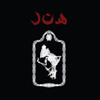Harappian Night Recordings, "The Glorious Gongs of Hainuwele"
 The title of this album alludes to a deeply macabre and scatological Indonesian myth about young girl who possessed the dubious magical ability to defecate surprising items ranging from earrings to knives to...well...gongs. When she distributed these items to men at a village dance, the villagers collectively decided that her power was an infernal and unseemly one and that they needed to bury her alive. Fortunately, the story has a happy (albeit grisly) ending, as her friend later dug up her corpse, dismembered it, and reburied its parts all over the village, which caused delicious tuberous plants to grow.
The title of this album alludes to a deeply macabre and scatological Indonesian myth about young girl who possessed the dubious magical ability to defecate surprising items ranging from earrings to knives to...well...gongs. When she distributed these items to men at a village dance, the villagers collectively decided that her power was an infernal and unseemly one and that they needed to bury her alive. Fortunately, the story has a happy (albeit grisly) ending, as her friend later dug up her corpse, dismembered it, and reburied its parts all over the village, which caused delicious tuberous plants to grow.
I am not sure quite what moral I should take away from this tale, as it seems to make a strong case for digging up and disfiguring corpses, but frowns upon public defecation. Regardless, the timeless, bizarre, and shadowy music of The Glorious Gongs of Hainuwele certainly approximates the sort of music that might’ve been playing at just such a memorable dance.
Syed Kamran Ali (one-third of The Hunter Gracchus) is one of the key figures in Sheffield’s recent resurgence in underground music prominence, a small but thriving scene centered around a disused factory and the Singing Knives label. On this, his solo debut, he performs an ingenious inversion of the Muslimgauze formula, appropriating exotic field recordings in order to create even more exotic (and imaginary) field recordings of his own.
Some material seems likely to have been culled from Africa and The Middle East, but Ali could just as easily have limited himself solely to the thematically appropriate region of Southeast Asia. Much more important than the origin of the base material is what Syed does with it. Actually, what he doesn’t do with it might be more important still: these songs sound completely raw, unpolished, and devoid of any conspicuous contemporary music influence. If anything, Ali seems to have artificially eroded, distressed, and overloaded his loops to make them sound even worse, though he clearly took cautions to avoid completely rendering the instruments unidentifiable. As a result, the music captured here sounds ancient and forgotten, very much akin to Nonesuch’s Explorer series, which documented everything from folk dances to voodoo rituals. The key difference, of course, is that the culture that Ali is documenting exists only in his head.
Syed covers a lot of stylistic and emotional territory here, which is what elevates the album from a cool idea or clever intellectual exercise into something truly unique and mesmerizing. For example, the ruined strings of “Mal De Ojo” and “Scarecrow” are haunting and heartbreaking to a degree that can only be achieved by a time-ravaged tape reel, while other tracks (like “Lila Derdeba") can be quite raucous and heavily rhythmic. There are also some moments that sound like a waterlogged tape of Tom Waits at his lurching, junkyard-percussion best, yet all these disparate threads somehow manage to fit seamlessly alongside flourishes of deranged and harsh experimentalism. Throughout it all, Ali displays an innate genius for keeping things hooky, hypnotic, and unwaveringly human. An experiment like this one is an easy one to ruin with too much tinkering, self-indulgence, repetition, and clutter, but Syed has managed to sidestep every peril to egolessly let the recontextualized loops lead him into strange and wonderful new territory.
Samples:



